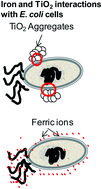TiO2 photocatalytic and near-neutral photo-Fenton processes were tested under simulated solar light to degrade two models of natural organic matter – resorcinol (R) (which should interact strongly with TiO2 surfaces) and hydroquinone (H) – separately or in the presence of bacteria. Under similar oxidative conditions, inactivation of Escherichia coli, Shigella sonnei and Salmonella typhimurium was carried out in the absence and in the presence of 10 mg L−1 of R and H. The 100% abatement of R and H by using a TiO2 photocatalytic process in the absence of bacteria was observed in 90 min for R and in 120 min for H, while in the presence of microorganisms abatement was only of 55% and 35% for R and H, respectively. Photo-Fenton reagent at pH 5.0 completely removed R and H in 40 min, whereas in the presence of microorganisms their degradation was of 60% to 80%. On the other hand, 2 h of TiO2 photocatalytic process inactivated S. typhimurium and E. coli cells in three and six orders of magnitude, respectively, while S. sonnei was completely inactivated in 10 min. In the presence of R or H, the bacterial inactivation via TiO2 photocatalysis was significantly decreased. With photo-Fenton reagent at pH 5 all the microorganisms tested were completely inactivated in 40 min of simulated solar light irradiation in the absence of organics. When R and H were present, bacterial photo-Fenton inactivation was less affected. The obtained results suggest that in both TiO2 and iron photo-assisted processes, there is competition between organic substances and bacteria simultaneously present for generated reactive oxygen species (ROS). This competition is most important in heterogeneous systems, mainly when there are strong organic–TiO2 surface interactions, as in the resorcinol case, suggesting that bacteria–TiO2 interactions could play a key role in photocatalytic cell inactivation processes.

You have access to this article
 Please wait while we load your content...
Something went wrong. Try again?
Please wait while we load your content...
Something went wrong. Try again?


 Please wait while we load your content...
Please wait while we load your content...